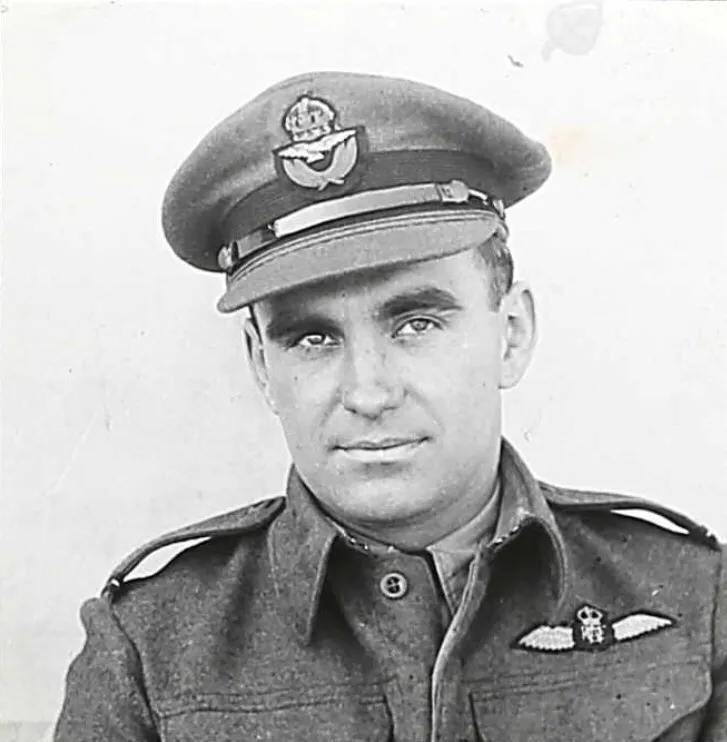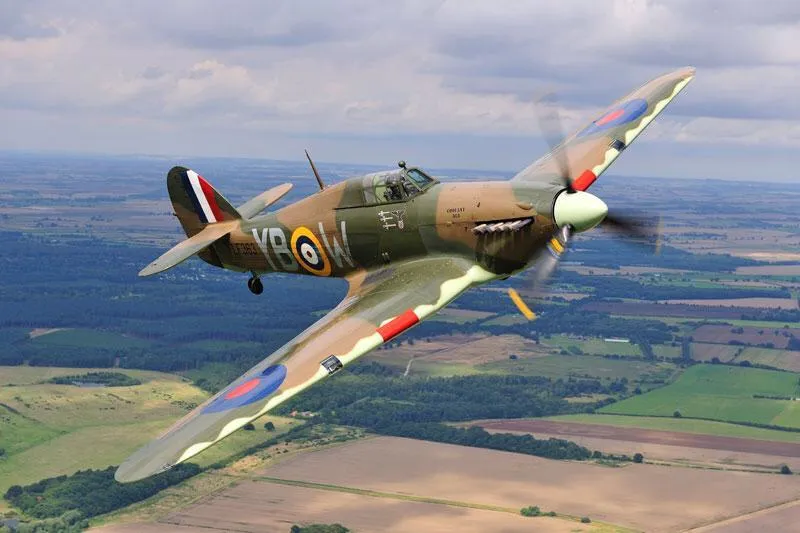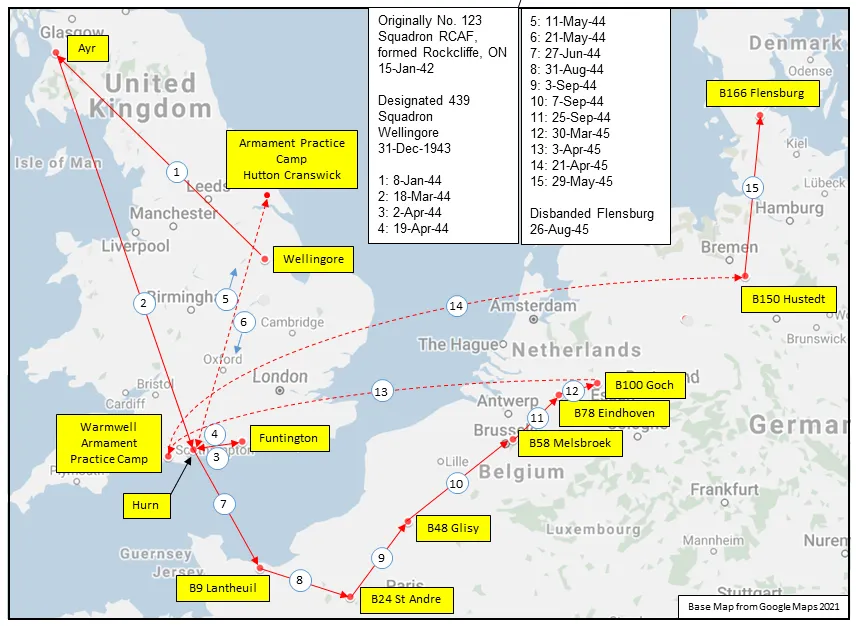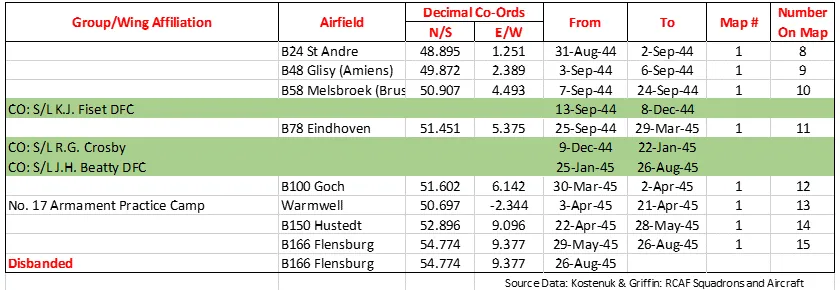Pollock, Norval Edward (Flight Lieutenant)
Killed in Action 1944-March-21


Birth Date: 1923
Born:
Parents: Son of Charles and Annie Pollock of London Ontario.
Spouse: Husband of Clarice Pollock of London Ontario
Home: Ripley, Ontario
Enlistment:
Enlistment Date: unkown date
Service
RCAF
Unit
439 Sqn- Squadron
Fangs of Death
Base
Rank
Flight Lieutenant
Position
Pilot
Service Numbers
J/14314
Home
Hurricane serial: LD972

Source BBMF
The Hawker Hurricane is a single-seat fighter aircraft of the 1930s"“1940s that was designed and predominantly built by Hawker Aircraft Ltd. for service with the Royal Air Force (RAF). The Hurricane developed through several versions, as bomber-interceptors, fighter-bombers, and ground support aircraft in addition to fighters. Versions designed for the Navy were popularly known as the Sea Hurricane, with modifications enabling their operation from ships. Some were converted to be used as catapult-launched convoy escorts. By the end of production in July 1944, 14,487 Hurricanes had been completed in Britain and Canada.
A major manufacturer of the Hurricane was Canadian Car and Foundry at their factory in Fort William (now Thunder Bay), Ontario. The facility's chief engineer, Elsie MacGill, became known as the "Queen of the Hurricanes". The initiative was commercially led rather than governmentally, but was endorsed by the British government; Hawker, having recognized that a major conflict was all but inevitable after the Munich Crisis of 1938, drew up preliminary plans to expand Hurricane production via a new factory in Canada. Under this plan, samples, pattern aircraft, and a complete set of design documents stored on microfilm, were shipped to Canada; the RCAF ordered 20 Hurricanes to equip one fighter squadron and two more were supplied to Canadian Car and Foundry as pattern aircraft but one probably did not arrive. The first Hurricane built at Canadian Car and Foundry was officially produced in February 1940. As a result, Canadian-built Hurricanes were shipped to Britain to participate in events such as the Battle of Britain. Canadian Car and Foundry (CCF) was responsible for the production of 1,451 Hurricanes. Wikipedia and Harold A Skaarup Web Page
Unit Desciption
439 Sqn Fangs of Death ("Westmount")
History of the Squadron before and during World War II (Aircraft: Hurricane IV, Typhoon IB)

[ Note that during WWII the squadron did not have a badge nor a motto. These were awarded later.]
No 439 (F) Squadron was formed in Rockcliffe, Ontario ![]() as No. 123 (Army Co-operation) Squadron RCAF Ontario, on Jan 15 1942. It was the second of six home squadrons transferred overseas without its aircraft, and was re-designated No. 439 (FB) Squadron RCAF at Wellingore, Lincolnshire, UK
as No. 123 (Army Co-operation) Squadron RCAF Ontario, on Jan 15 1942. It was the second of six home squadrons transferred overseas without its aircraft, and was re-designated No. 439 (FB) Squadron RCAF at Wellingore, Lincolnshire, UK ![]() on December 31, 1943. It flew Typhoon aircraft in the preparation for D-Day and afterwards gave close support to the ground troops by dive-bombing and strafing enemy strongpoints, bridges, and road and rail traffic. They moved with the ground troops through France, the Low Countries, and Germany. The squadron was disbanded at Flensburg, Germany
on December 31, 1943. It flew Typhoon aircraft in the preparation for D-Day and afterwards gave close support to the ground troops by dive-bombing and strafing enemy strongpoints, bridges, and road and rail traffic. They moved with the ground troops through France, the Low Countries, and Germany. The squadron was disbanded at Flensburg, Germany ![]() on August 26, 1945.
on August 26, 1945.
In the course of operations, the squadron flew 3996 sorties for the loss of 41 aircraft and 37 pilots, of whom 19 were killed, 9 missing, and 6 POWs. They dropped 2108 tons of bombs and accounted for a large number of rail and road vehicles. The squadron amassed 12 DFCs. Battle Honours were: Fortress Europe 1944, France and Germany 1944-45, Normandy 1944, Rhine.Wikipedia, Kostenuk and Griffin
Maps for Movements of 439 Squadron 1943-45

MAP 1: 439 Squadron Movements 1943-45 (right-click on image to display enlarged in new tab)
|
439 Squadron History Summary 1943-45

439 Squadron History Summary 1943-45

History of the Squadron Post-WWII (Aircraft: Sabre 2, 5, 6, Starfighter, Hornet, Griffon)

The squadron was re-formed as a Fighter unit at Uplands (Ottawa), Ontario ![]() on 1 September 1951 equipped with Canadair Sabre aircraft. The squadron joined No. 1 (Fighter) Wing at North Luffenham, Nottinghamshire, England
on 1 September 1951 equipped with Canadair Sabre aircraft. The squadron joined No. 1 (Fighter) Wing at North Luffenham, Nottinghamshire, England ![]() in June 1952. In doing so, it initiated the first of four Operations “Leapfrog†– mass transatlantic flights by Sabre-equipped units to No. 1 Air Division Europe. Despite bad weather throughout the move, the 21 aircraft made the 3560-mile trip without mishap, to complete the formation of No. 1 Wing. Early in 1955, the unit moved with the wing to its French base at Marville
in June 1952. In doing so, it initiated the first of four Operations “Leapfrog†– mass transatlantic flights by Sabre-equipped units to No. 1 Air Division Europe. Despite bad weather throughout the move, the 21 aircraft made the 3560-mile trip without mishap, to complete the formation of No. 1 Wing. Early in 1955, the unit moved with the wing to its French base at Marville ![]() . Selected as one of eight squadrons of No. 1 Air Division Europe to be re-equipped with CF-104 Starfighter aircraft, it was deactivated on 1 November 1963 and reactivated as Strike Reconnaissance on 2 March 1964. They moved with 3 Wing to Lahr, Germany
. Selected as one of eight squadrons of No. 1 Air Division Europe to be re-equipped with CF-104 Starfighter aircraft, it was deactivated on 1 November 1963 and reactivated as Strike Reconnaissance on 2 March 1964. They moved with 3 Wing to Lahr, Germany ![]() on April 1, 1967, then to CFB Baden-Soellingen, Germany
on April 1, 1967, then to CFB Baden-Soellingen, Germany ![]() in 1971 as 439 Tactical Fighter Squadron. The squadron disbanded in November 1984 and reformed in November 1985 with the CF-18. During the Gulf War, the squadron fought as part of the Coalition of the Gulf War. They were disbanded at Baden-Soellingen on May 15, 1993 and reactivated shortly after at 3 Wing Bagotville, Quebec
in 1971 as 439 Tactical Fighter Squadron. The squadron disbanded in November 1984 and reformed in November 1985 with the CF-18. During the Gulf War, the squadron fought as part of the Coalition of the Gulf War. They were disbanded at Baden-Soellingen on May 15, 1993 and reactivated shortly after at 3 Wing Bagotville, Quebec ![]() as 439 Combat Support Squadron.
as 439 Combat Support Squadron.
The role of a Combat Support Squadron is to provide an immediate response to aircraft emergencies for operational squadrons flying out of 3 Wing Bagotville. As a secondary role, the Squadron can be called on to augment Search and Rescue operations in the region, tasked by the Joint Regional Co-ordination Centre. The squadron’s crews train continually in order to ensure an extremely high level of proficiency and this often means training with outside agencies like the Canadian Coast Guard, CASERA/SERABEC or local police. The squadron is only able to reach this level of proficiency thanks to the tireless support of its maintenance personnel who are dedicated to keeping the CH-146 flying. 439 combat support squadron’s crews, maintainers and aircraft are also often tasked with supporting Operation LENTUS in the event of domestic natural disasters necessitating the Canadian Armed Forces’ assistance.